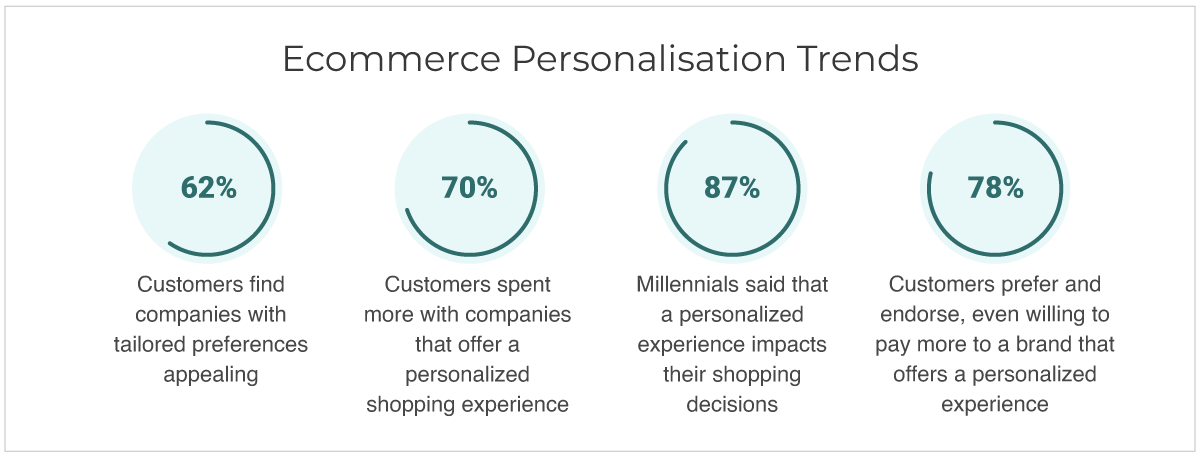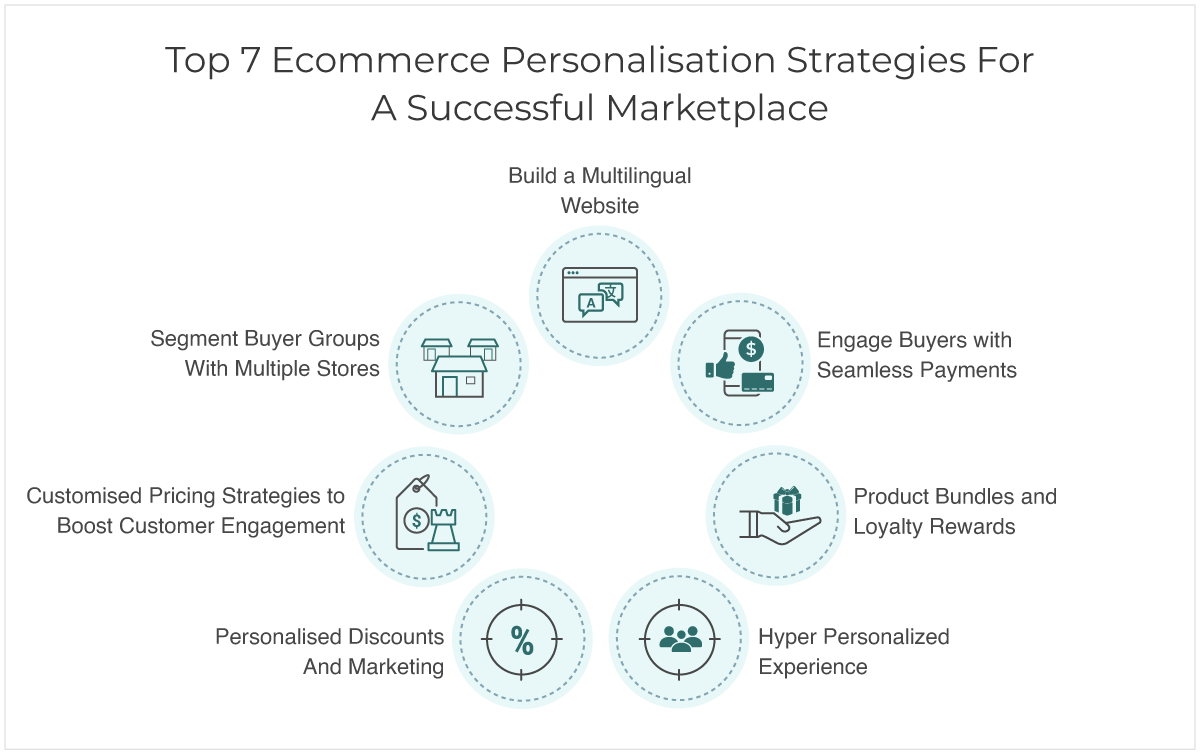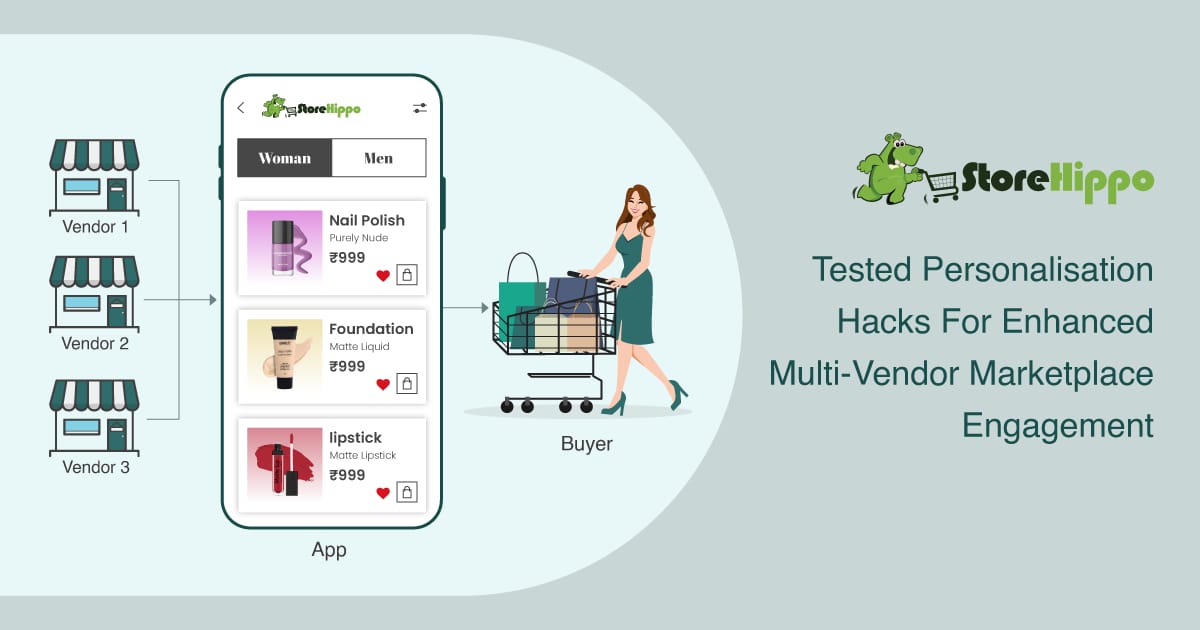The e-commerce market is transforming rapidly, and multi-vendor marketplaces have become immensely popular. Who doesn’t want to be the next Amazon, right?
The ability to offer various products and services under one virtual roof makes multi-vendor marketplace platforms a significant cornerstone in the future of e-commerce.
But it is a highly competitive market and as competition grows, how do you stand out and keep your customers engaged?
The answer is ecommerce personalisations.
Shoppers today expect tailored experiences and businesses that deliver on this expectation have a clear edge.
So, let’s delve deeper into the world of ecommerce personalisations and explore how they can transform your multi-vendor marketplace into a successful customer-centric hub.
Table of Contents
- How Personalisation Fuels the Growth of Multi-Vendor Marketplaces
- 7 Personalization Hacks to Skyrocket Multi Vendor Marketplace Engagement
- 1. Build a Multilingual Website
- 2. Segment Buyer Groups With Multiple Stores
- 3. Customised Pricing Strategies to Boost Customer Engagement
- 4. Personalised Discounts And Marketing
- 5. Analytics-powered Insights for a Hyper Personalized Experience
- 6. Product Bundles and Loyalty Rewards
- 7. Engage Buyers with Seamless Payments
- How StoreHippo Helps You Implement Ecommerce Personalisation On Your Marketplace
- Conclusion
How Personalisation Fuels the Growth of Multi-Vendor Marketplaces
User engagement is an important criterion for a multi-vendor marketplace to thrive. Creating an innovative multi-vendor marketing strategy is the only way to stand out in this competitive market and keep your users interested.
In 2025 and beyond, e-commerce personalisations will be the game changer for businesses. To help you create a personalisation strategy that stays up-to-date with the ever-changing future of ecommerce, let us first evaluate the latest market trends vis-a-vis personalisation;

- 62% of customers find companies with tailored preferences appealing
- 70% of the customers spent more with companies that offer a personalized shopping experience.
- 87% of millennials said that a personalized experience impacts their shopping decisions.
- 78% of customers prefer and endorse, even willing to pay more to a brand that offers a personalized experience.
Source: Statista
These statistics showcase the power of personalisation in driving engagement and generating revenue. With this in mind, let’s explore the multi-vendor marketing strategies that can help you make personalisation a defining feature of your marketplace!
7 Personalization Hacks to Skyrocket Multi Vendor Marketplace Engagement
Modern buyers are choosy and have a shorter attention span, making personalization a must-have for eCommerce success. They expect tailored experiences that cater to their unique preferences, and businesses that deliver stand out in the competitive ecommerce domain.

Here are 7 powerful personalization strategies that can transform your multi-vendor marketplace and drive exceptional engagement.
1. Build a Multilingual Website
As your business grows, breaking language barriers becomes essential to reaching a broader, more diverse audience. A multilingual website or application allows your marketplace to connect with customers across different regions, creating a seamless and inclusive shopping experience.
Key strategies for an effective multilingual multi-vendor marketplace website:
- Automatic Translations: Use AI-powered tools for instant translations into multiple languages, ensuring customers can browse and shop comfortably in their preferred language.
- Manual Fine-Tuning: Enhance translation accuracy and cultural relevance by refining content to match the tone and preferences of specific regions.
- RTL Language Support: Incorporate Right-to-Left language compatibility for Arabic, Hebrew, and similar scripts to cater to diverse global audiences effectively.
- Geographic Language Detection: Automatically display the appropriate language based on a user’s location or saved preferences to personalise the experience and send a message that your business is ready for the future of e-commerce.
By incorporating these strategies, you not only improve user engagement but also establish your marketplace as a global player. A multilingual website signals that your business is ready to meet the expectations of an interconnected world, fostering trust and driving conversions in new markets.
2. Segment Buyer Groups With Multiple Stores
In a competitive multi-vendor marketplace environment, catering to diverse buyer segments is crucial for sustained growth. Segmenting your audience through multiple storefronts allows you to create tailored experiences for different customer groups, industries, or regions, making your platform more relevant and engaging.
Key strategies for segmenting buyers with multiple stores:
- Customised Storefronts: Create unique stores for different customer segments, such as wholesale buyers, retail shoppers, or region-specific audiences, with personalised layouts, catalogs, and offerings.
- Localised Ecommerce Personalisations: Offer region-specific content, pricing, and promotions to resonate with local buyers and drive engagement.
- Flexible Product Catalogs: Showcase products or categories relevant to specific buyer groups, enhancing their shopping experience and boosting conversions.
- Centralized Management: Use a single backend to manage multiple stores effortlessly, ensuring operational efficiency and consistency across all touchpoints.
By segmenting buyer groups with multiple stores, your multi-vendor marketplace can deliver personalized shopping experiences that cater to the unique needs of each audience. This approach not only increases customer satisfaction but also positions your marketplace as a leader in eCommerce personalisations, fostering loyalty and driving revenue across diverse markets.
3. Customised Pricing Strategies to Boost Customer Engagement
In a multi-vendor marketplace, one-size-fits-all pricing often falls short of meeting diverse customer needs. Customised pricing strategies allow you to cater to various buyer groups—whether individual shoppers, bulk buyers, or regional customers—by offering tailored pricing that resonates with their preferences and purchasing patterns.
Key strategies for implementing customised pricing:
- Location-Based Pricing: Use IP detection to offer region-specific prices that align with local market demands and purchasing power.
- Tiered Pricing Models: Provide volume-based discounts for bulk buyers or B2B customers, encouraging larger transactions.
- Login-Based Pricing: Offer exclusive pricing for premium members, loyal customers, or specific buyer segments to enhance engagement.
- Pricing Override: Implement rule-based pricing that adapts to customer login, or seasonal user segmentation.
- RFQ Features: Allow B2B buyers to request quotes and negotiate prices, creating a personalised and customer-centric buying experience.
By adopting these customised pricing strategies, your online marketplace can be ready for the future of e-commerce where delivering highly relevant and engaging experiences for customers is the norm. These ecommerce personalisations not only improve customer satisfaction but also drive loyalty and maximize revenue by aligning pricing with buyer expectations and market conditions.
4. Personalised Discounts And Marketing
Personalized discounts for targeted marketing is powerful tools for driving engagement and conversions in a multi-vendor marketplace. By tailoring offers to specific customer behaviors, preferences, and segments, you create a more relevant shopping experience that keeps buyers coming back.
Key strategies for personalized discounts and marketing:
- Behavior-Based Offers: Use customer browsing and purchase history to offer product-specific discounts or time-sensitive deals.
- Geo-Targeted Promotions: Create discounts and campaigns tailored to specific regions or customer locations.
- Cart Abandonment Recovery: Send personalized reminders with exclusive discounts to re-engage customers and recover lost sales.
- Dynamic Discounts: Implement a rule engine to automatically apply multi-level discounts for bulk buyers or loyal customers.
- Segmented Campaigns: Use buyer group segmentation to run targeted email or push notification campaigns, offering promotions relevant to each group.
By leveraging these personalized discount and marketing strategies, your multi-vendor marketplace can deliver exceptional ecommerce personalisations, boost customer satisfaction, and drive higher ROI. Tailored offers create a sense of exclusivity and value, helping your marketplace stand out in a competitive landscape.
5. Analytics-powered Insights for a Hyper Personalized Experience
In today’s fast-paced eCommerce environment, where an average online customer has an attention span of 8 seconds, understanding customer behavior is the key to delivering hyper-personalized experiences. Analytics-powered insights enable multi-vendor marketplaces to go beyond generic data, uncovering detailed patterns in buyer behavior, preferences, and engagement.
Key strategies to leverage analytics for ecommerce personalisation:
- Customer Segmentation: Group customers based on browsing habits, purchase history, demographics, or location to create targeted experiences.
- Behavioral Insights: Use analytics to identify preferred shopping times, product categories, and channels, enabling tailored offers and recommendations.
- Real-Time Data Tracking: Monitor customer interactions to deliver personalized content, such as dynamic product suggestions or location-based discounts.
- Predictive Analytics: Leverage AI-driven tools to predict future customer preferences and proactively offer relevant products or deals.
- Performance Metrics: Track vendor-specific performance, product popularity, and buyer trends to optimize marketplace offerings.
By integrating analytics into your multi-vendor marketplace, you can unlock powerful eCommerce personalisations that captivate customers and build loyalty. Platforms like StoreHippo make it easy to harness these insights with built-in analytics tools, enabling data-driven decisions that improve engagement, boost conversions, and future-proof your marketplace.
6. Product Bundles and Loyalty Rewards
Combining product bundles with loyalty rewards is a powerful personalisation strategy to drive sales and encourage repeat purchases on a multi-vendor marketplace. By offering bundled deals and rewarding loyal customers, you can create value-packed experiences that boost engagement and customer satisfaction.
Key strategies for product bundles and loyalty rewards:
- Tailored Bundles: Offer product bundles based on customers’ past purchases or browsing history to meet their specific needs.
- Dynamic Discounts: Provide special pricing for bundles, such as “Buy 2, Get 1 Free,” or percentage-based discounts for bundled products.
- Loyalty Points System: Reward customers with points for every purchase, which can be redeemed for discounts, freebies, or exclusive offers.
- Tiered Loyalty Rewards: Create tiered programs where higher spending unlocks better rewards, encouraging increased purchases.
- Seasonal Bundles: Promote holiday or event-specific bundles to align with customer buying trends.
By integrating product bundles and loyalty rewards into your marketplace strategy, you can enhance customer retention, boost average order values, and build long-term relationships with your buyers. Personalizing these offers ensures customers feel valued and incentivized to shop frequently.
7. Engage Buyers with Seamless Payments
In a multi-vendor marketplace, a smooth and hassle-free payment process is essential for creating a positive shopping experience. Seamless payment options not only enhance customer satisfaction but also encourage repeat purchases, fostering long-term loyalty.
Key strategies for implementing seamless payments:
- Multiple Payment Options: Offer a variety of payment options, including credit/debit cards, UPI, wallets, net banking, COD, and EMI, to cater to diverse customer preferences.
- Localized Payment Methods: Integrate region-specific payment gateways to make transactions easier for international buyers.
- Store Wallets: Enable customers to store funds securely in a digital wallet, allowing instant refunds, cashback rewards, and hassle-free transactions.
- Real-Time Currency Conversion: Provide multi-currency support to offer seamless transactions for global customers.
By implementing these seamless payment solutions, your marketplace can deliver exceptional ecommerce personalisations, reduce cart abandonment rates, and increase buyer satisfaction. Prioritizing an intuitive and secure payment experience builds trust, drives loyalty, and strengthens your multi-vendor marketplace’s reputation as a customer-centric platform.
How StoreHippo Helps You Implement Ecommerce Personalisation On Your Marketplace
StoreHippo’s future-ready technology and multi-vendor marketplace solutions are designed to empower your marketplace with advanced ecommerce personalisations.
Here’s how StoreHippo helps you deliver tailored experiences that boost engagement and drive sales:
- Mobile-First Technology: Engage mobile shoppers with PWA (Progressive Web Apps) stores and inbuilt mobile apps that deliver app-like experiences across devices.
- Built-in Design Tools: StoreHippo’s intuitive drag-and-drop tools and customizable themes allow you to create visually appealing and user-friendly storefronts for your multi-vendor marketplace. Tailor layouts, colors, and content to reflect your brand and enhance customer engagement.
- Multi-Store Solutions: Manage multiple storefronts from a single backend with StoreHippo’s multi-store architecture. Segment your audience by geography, customer type, or product category, delivering personalized ecommerce experiences across sub-stores.
- Comprehensive Marketplace Solutions: StoreHippo’s feature-rich marketplace solutions include multi-vendor management, real-time analytics, vendor-specific dashboards, and automated commission calculations. These tools simplify operations for admins and vendors while improving the overall customer experience.
- Headless Architecture for Customisation: StoreHippo’s decoupled frontend and backend allow you to build personalized buyer journeys, from tailored product recommendations to custom workflows, ensuring unique experiences for each customer segment.
- Dynamic Pricing and Discounts: Implement location-based, tiered, or login-specific pricing using StoreHippo’s versatile pricing engine. The built-in discount engine lets you create targeted promotions like product-level discounts, flash sales, and group-specific offers.
- Multilingual and Multi-Currency Support: Reach global audiences with seamless localization features, including automatic translations, RTL language support, and multi-currency payments, ensuring a personalized shopping experience for every customer.
- Built-in Marketing Tools: StoreHippo’s SEO-friendly platform comes with a host of native marketing tools like discount engine, blog engine, abandoned cart follow up, push notifications, and more that keep your marketing game ready for the future of ecommerce.
- Vendor-Specific Tools: Empower vendors with dedicated dashboards for managing inventory, sales analytics, and customized pricing. Features like vendor-specific discounts and personalized seller pages enhance the marketplace’s appeal.
- Multiple Payment Options: StoreHippo integrates with 60+ payment gateways, offering diverse payment methods such as UPI, wallets, EMI, credit/debit cards, and multi-currency support. This ensures seamless and localized payment experiences for customers globally. Encourage repeat purchases with secure wallet systems and customizable loyalty rewards, creating lasting relationships with your customers.
- Inbuilt Analytics for Insights: Use StoreHippo’s advanced analytics to segment customers, track behavior, and identify trends. Leverage these insights to implement hyper-personalized strategies like tailored recommendations or targeted marketing campaigns.
StoreHippo combines cutting-edge technology and net-gen solutions to future-proof your multi-vendor marketplace. By enabling seamless personalisation, it helps you cater to diverse buyer needs, foster loyalty, and stay ahead in the competitive world of eCommerce.
Conclusion
Personalisation is no longer just a feature—it’s the cornerstone of success for any multi-vendor marketplace in 2025 and beyond. By implementing the above listed ecommerce personalisation strategies, you can enhance customer experiences, drive engagement, and significantly boost marketplace sales on your marketplace website.
With the right approach to multi-vendor marketing and a powerful multi vendor solution provider like StoreHippo, your marketplace can stand out in the competitive landscape, offering tailored solutions that foster customer loyalty and increase revenue. Embrace these strategies to position your business as a leader in the future of ecommerce, ensuring long-term growth and success.
Explore 300+ enterprise grade features of StoreHippo that enable your brand to implement the most innovative ecommerce personalisation strategies.
Begin your 14-day free trial now.

